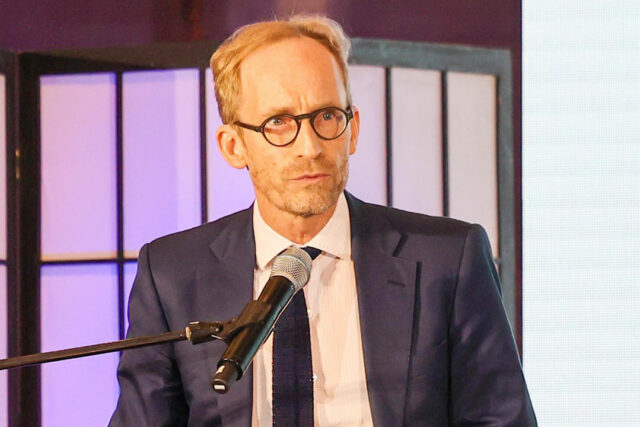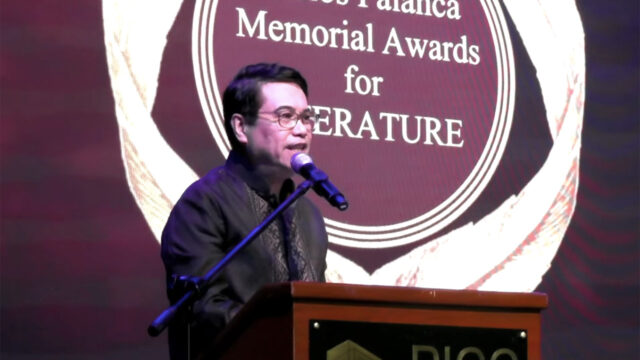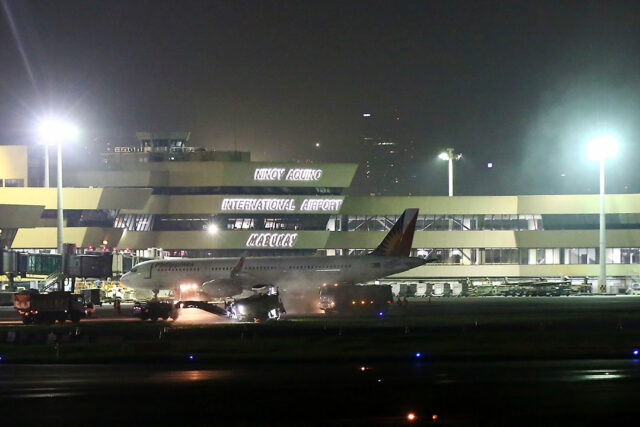FROM 1,405 ENTRIES, the 71st Carlos Palanca Memorial Awards for Literature chose 54 winners, of which 30 are first-time awardees. The annual ceremony recognizing Filipinos who exhibit the gold standard in writing excellence was held at the Philippine International Convention Center in Pasay City on Monday night.
There were 20 writing categories awarded as the Novel and Nobela categories were not open this year. These categories are open only every two years.
Biologist and research associate Rio Renato Pulido Constantino was awarded the Essay category grand prize for “The Year of the Periwinkle.” The essay is a reflection on the importance of soil and plants in grounding people, written during Mr. Constantino’s ordeal with cancer over the span of a year.
Meanwhile, another first-time awardee was teacher Kimberly Rose L. Pillo, who won the grand prize in the Sanaysay category. Her honest piece, “Kung Paanong Nagmukha akong Sponge sa harap ng mga Pinggan,” helped her clinch the award, a dream come true that she never expected.
The youngest winners this year are 13-year-old twin sisters, Glorious Zavannah Exylin C. Alesna and Glorious Zahara Exylin C. Alesna, who took home the third and second prizes for the Filipino and English essay categories in the Kabataan Division respectively.
BIG WINNERS
There were two big winners that evening.
Playwright Miguel Antonio Alfredo V. Luarca won first place in both Filipino and English full-length play categories for his works Nekropolis and Dogsblood.
Meanwhile, Ian Rosales Casocot, a teacher at the English Department of Siliman University in Dumaguete, bagged 2nd place in three categories in the English division: short story (“Don’t Follow Me, I Don’t Even Know Where I’m Going”), poetry for children (“Bisaya for all that we gugma”), and one-act play (The Midsummer of Manuel Arguilla). This brings his total haul of Palanca Awards through the years to nine.
THE ROLE OF WRITERS
Every Filipino writer, regardless of age, gender, medium or genre of choice, or years of experience, has a role in nation-building, said Dr. Luis P. Gatmaitan, guest of honor at the awarding ceremony.
“Noong pandemya, iniligtas tayo ng mga kuwento (During the pandemic, stories saved us),” said Mr. Gatmaitan in his speech.
An award-winning children’s book author, columnist, and radio host inducted into the Palanca Awards Hall of Fame in 2005, Mr. Gatmaitan said that stories in any shape, form, or platform can be more effective in relaying messages than plain facts and figures.
Studies have shown that only two areas of the brain are activated while taking in facts and figures whereas three areas are activated when reading or listening to stories, he said.
“This makes our role as writers very important.”
Meanwhile, Criselda Cecilio-Palanca, in a speech representing the family behind the award, pointed out that artificial intelligence can never really replace writers.
“Nuance, poignance, ambience, petulance, pathos, subtlety, irony, and humor are some of the many variables that are still on our side,” she said.
Established in 1950 in memory of Don Carlos Palanca Sr., the Palanca Awards aims to develop Philippine literature by providing incentives for writers, to serve as a treasury of Philippine literary gems, and to assist in their dissemination. — Brontë H. Lacsamana
Winners of the 71st Palanca Awards
FILIPINO DIVISION
MAIKLING KUWENTO
1st prize — “Ang Tariktik” by Peter Solis Nery
2nd Prize — “Buwaya” by Jay Jomar F. Quintos
3rd Prize — “Boses Pusa” by Ella Jane G. Hermonio
MAIKLING KUWENTONG PAMBATA
1st prize — “Si Toyo at si Suka” by Jaylord S. Losabia
2nd Prize — “Si Liya at ang Dapithapon sa Ilaya” by Mikka Ann V. Cabangon
3rd Prize — “Babasagin, babasagin!” by Iza Maria G. Reyes
SANAYSAY
1st prize — “Kung Paanong Nagmukha akong Sponge sa harap ng mga Pinggan” by Kimberly Rose L. Pillo
2nd Prize — “Auslander: Mga Danas sa Alemanya” by Al Joseph A. Lumen
3rd Prize — “Ako ay si Ako nga” by Edward Joseph Fernandez
TULA
1st prize — “Epistolaryo ng Bagamundo at ang tugon ng Multo” by Mikael de Lara Co
2nd Prize — “Ang Hindi Maiwasang Patlang” by Rogelio dela Rosa, Jr.
3rd Prize — “Ex Novo Mvndo” by Ralph Lorenz G. Fonte, M.D
TULA PARA SA MGA BATA
1st prize — “Tutula, Tutuli, Tutulo” by Dexter B. Gragasin
2nd Prize — “Ako, mga tulang pambata” by Genaro R. Gojo Cruz
3rd Prize — “Tugma ng Buhay kong Payak” by Keisiah Dawn T. Tiaoson
DULANG MAY ISANG YUGTO
1st prize — Ang Lipnayan ng ating mga Katawan by Eljay Castro Deldoc
2nd Prize — The Divine Family by Dan Ian Paulo B. Mariposque
3rd Prize — Fermata by Dustin Edward D. Celestino
DULANG GANAP ANG HABA
1st prize — Nekropolis by Miguel Antonio Alfredo V. Luarca
2nd Prize — Pingkian by Christian R. Vallez
3rd Prize — Atin ang Panahon by Joshua Lim So
DULANG PAMPELIKULA
1st prize — Love Child by Jonathan P. Jurilla
2nd Prize — Elehiya by Jimmy F. Flores and Emmanuel Q. Palo
3rd Prize — Beki Naman by Raymund T. Barcelon
ENGLISH DIVISION
SHORT STORY
1st prize — “Vile Creatures” by Exie Abola
2nd Prize — “Don’t Follow Me, I Don’t Even Know Where I’m Going” by Ian Rosales Casocot
3rd Prize — “Amadito and Amanda” by Katrina D. Torralba
SHORT STORY FOR CHILDREN
1st prize — NO WINNER
2nd Prize — “The Legend of Ipot-ipot” by Jonny Bernas Pornel
3rd Prize — “The Race to Uswag” by Elvie Victonette B. Razon-Gonzalez
ESSAY
1st prize — “The Year of the Periwinkle” by Rio Renato Pulido Constantino
2nd Prize — “Profile of a Stateless Person: Notes on a Deportation Proceeding” by Russell Stanley Geronimo
3rd Prize — “Normalizing Survival” by Francine M. Marquez
POETRY
1st prize — “Translating Wildfires” by Patricia Mariya Shishikura
2nd Prize — “Carrying” by Vince Raphael V. Agcaoili
3rd Prize — “Lou Reed Meets Delmore Schwartz at a Bar” by Michael Maniquiz
POETRY WRITTEN FOR CHILDREN
1st prize — “Odd Numbers” by John Patrick F. Solano
2nd Prize — “Bisaya for all that we gugma” by Ian Rosales Casocot
3rd Prize — “Paper Planes” by Simone Marie Sales
ONE-ACT PLAY
1st prize — Neneng by Randy Q. Villanueva
2nd Prize — The Midsummer of Manuel Arguilla by Ian Rosales Casocot
3rd Prize — My Lover’s Presscon by Rossielle Sarabia Manicad
FULL-LENGTH PLAY
1st prize — Dogsblood by Miguel Antonio Alfredo V. Luarca
2nd Prize — NO WINNER
3rd Prize — NO WINNER
REGIONAL DIVISION
SHORT STORY-CEBUANO
1st prize — “Lenteng Pilokilay” by Neile Genica M. Sy
2nd Prize — “Ang Magsusulat Nga Haduol na sa Kamatayon” by John Dante
3rd Prize — “Alindasay” by CD Borden
SHORT STORY-HILIGAYNON
1st prize — “Kauhaw sa Tingadlaw” by Ritchie D. Pagunsan
2nd Prize — “Lola Violeta” by Alvin Q. Larida
3rd Prize — “Puno sang Aligotgot” by Serafin I. Plotria, Jr.
SHORT STORY-ILOKANO
1st prize — “Diro Ti Disierto” by Rodolfo D. Agatep, Jr.
2nd Prize — “Idiay Langit, Awan Lanit” by Jorge Richard P. Guerrero
3rd Prize — “Piglatan” by Clarito De Francia
KABATAAN DIVISION
SANAYSAY
1st prize — NO WINNER
2nd Prize — “Aranya sa Kisame” by Amancio A. Caponpon V
3rd Prize — “Sa Panahon ng Bagabag at Balisa: Paghagilap sa Pira-pirasong Retaso ng Hinahon at Pa(g)hinga” by Glorious Zavannah Exylin C. Alesna
ESSAY
1st prize — “Living on play in a world on pause” by Francis Roberto San Antonio Sevillena
2nd Prize — “The Bully is you” by Glorious Zahara Exylin C. Alesna
3rd Prize — “Five More Minutes, Please!” by Rheyn Khrieztine S. Dela Pena














